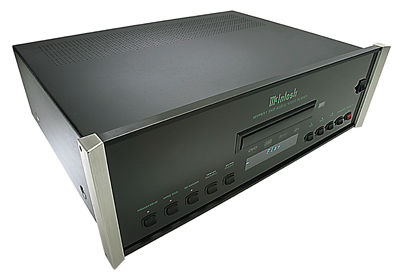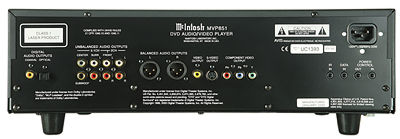McIntosh MVP851 DVD-Audio/Video player

Times change. By the mid-'70s, McIntosh was fighting for its share of the high-end audio market, surrounded on all sides by a host of new high-end audio startups, many of them among today's major players, others long gone. But in 1990, Clarion Corporation purchased McIntosh, and with an infusion of cash and talented personnel, the company began to turn around. In the past 13 years, McIntosh has continuously improved and refined their products, to the point where they have rejoined the handful of elite companies whose products define high-end audio and home theater.
The MVP851 DVD-Audio/Video player represents McIntosh's first foray into the world of full-featured DVD-A players. Whether "MVP" stands for "most valuable performer" or merely "McIntosh video player" remains to be seen. Let's take a bite of the latest fruit from McIntosh's orchard.
The Core
The MVP851 can handle DVD-Audio, DVD-Video, DVD-R, Video CD, CD-R/RW, MP3, and standard "Red Book" CDs. Only SACDs won't pass through its circuits. Burr-Brown 24-bit/192kHz D/A converters and built-in Dolby Digital and DTS decoders provide the MVP851 with optimal analog audio.
For CDs, the MVP851 includes a special digital remastering circuit that upsamples 44.1kHz CDs to 88.2kHz. It also redithers them to achieve a longer digital word length to simulate the sound quality of DVD-Audio. With its three different remastering settings, the listener can choose the exact amount of upper-frequency extension preferred.
The MVP851's video circuits include a 12-bit, 54MHz video D/A converter and front-panel-switchable 480i/480p component output. Regardless of what kind of disc you play, the digital servomotor, the fast and quiet platter mechanism, and the dual-focus lens make for quick disc reads. Options for field- or frame-selected still images, five-speed scan, and variable slow-motion speed ensure that freeze-frames and slo-mo pictures will be clear and jitter-free. For playing back less-than-perfect sources, McIntosh includes several noise-reduction circuits. Basic NR can be accessed from the front panel, while the onscreen display menu lets you access more sophisticated filters with different levels of 3D digital noise reduction.
The MVP851's rear panel leaves plenty of room for connecting cables. Unlike many DVD players, the MVP851 has only one set of S-video, composite, and component outputs. If you need to feed multiple systems of the same type from an MVP851, you'll have to do so through an external video distribution amp, an option most professional installers will encourage—such devices can drive long runs of video cable far better than any DVD player.
The remaining output options include one set of 5.1-channel analog audio, one pair of single-ended audio, one pair of XLR balanced audio, optical TosLink digital audio, and coaxial digital audio. Again, some installations may be cramped by so few outputs, but I suspect that reviewers and other devotees of A/B comparisons are the ones who will be most bothered by the lack of redundant outputs. Of course, if the MVP851 is coupled to a McIntosh A/V processor, such as the MX134 pre-pro or MHT200 receiver, its output connections should prove quite sufficient—the MVP851 was designed with just such a mate in mind.

Like the many McIntosh components before it, the MVP851's front panel is a shiny black glass face with green backlit labels—the classic design looks just as elegantly au courant now as it did when first introduced in the late '50s. Symmetrically arranged buttons line the panel's lower edge, and although the front panel lacks a jog/shuttle control, all other critical controls are present. Even the Power switch, usually found on a high-end component's rear panel, sits on the MVP851's front, right next to Standby/On. Besides standard Play, Pause, Stop, FF/Next, Back/Rev, and Open/Close buttons, the MVP851 has Re-Master, MPG DNR, and Progressive/Interlace. Putting the P/I switch on the front, along with a small red LED to indicate which scan mode is engaged, makes life much easier. Being able to tell at a glance whether the player is outputting an interlaced or progressive signal saves a lot of aggravation during setup. McIntosh understands: ergonomics count.
Although it's based on a Panasonic RP91 chassis (except for the platter mechanism and video board), everything on the MVP851 has been replaced with proprietary McIntosh circuits. Instead of Panasonic's stock digital switching power supply, the MVP851 uses a massive R-core power transformer—the same kind of transformer used for power amps. This level of technical overkill reappears throughout the MVP851's interior. With its top-quality parts and elegant circuit designs, the MVP851 represents McIntosh's thinking on what it takes to make the ultimate DVD player.
Many a fine DVD player is tripped up by a bad remote control, but the MVP851's is among the best I've used. Not only does it light up at the push of a button, its topography is logical and easy to use. A centrally located jog/shuttle control divides the remote's real estate in half, the more frequently used buttons above, the chapter and mode buttons below. The remote had excellent range—rarely did I have to push a button more than once to achieve the desired effect.
Scrapple from the Apple
Using the MVP851's basic setup menus, you can adjust all the standard settings: aspect ratio, black level, audio output level, channel balance, speaker size, rear-channel delay, and still mode. The bass-management crossover is fixed at the THX standard of 80Hz, and listening tests indicated that it functions on the DVD-Audio outputs. Other critical picture adjustments are found in a separate Display menu: sharpness, contrast, brightness, color intensity, tint, gamma, progressive transfer mode, video processing mode, high sharpness, edge sharpness, vertical sharpness, and three types of noise reduction (3D, block, and mosquito).
All of this is similar to the feature set found on current-production Panasonic players. Having reviewed a few Panasonic-based players, SGHT Editor Tom Norton assures me that this arrangement can become second nature. Still, first-time users of the MVP851 will spend some time scratching their heads and turning pages in the owner's manual as they negotiate its ins and outs. I wish all controls were in a single menu.
Speaking of the manual, it's far better than many I've seen, but it's not perfect. It doesn't fully detail all of the MVP851's features, including the player's ability to remember an individual disc's settings—a significant attribute. The MVP851 can remember the complete setup parameters for 200 movies. For especially well-mastered movies, such as Sony's Super Bit Map version of The Fifth Element, the MVP851 can retain your preferences for Fine picture detail and no noise reduction. When you watch mediocre video transfers such as Xena: Warrior Princess, it can invoke maximum noise reduction and a bit of edge enhancement, and it will remember your settings years later. How cool is that?













































